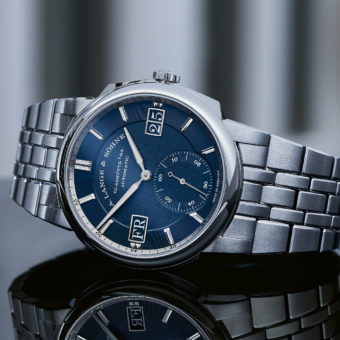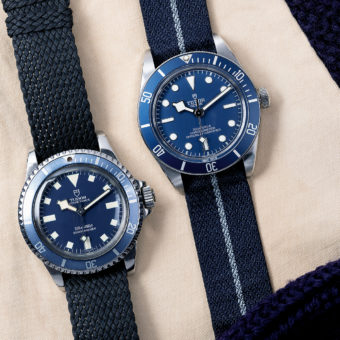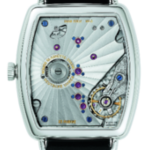
Nomos is known for its affordable manufacture watches. With its white-gold Lux model, the Glashütte-based brand entered a higher price range. Writer Jens Koch takes us deep into the timepiece and Nik Schölzel and Nomos provide outstanding photography.
For years, Nomos built simple, hand-wound watches and was known for value. Gradually, the company, based in the German town of Glashütte, augmented those basic models with additional features: a date display, automatic winding, a power-reserve display and even a world-time indicator. As it did so, Nomos steadily lifted the upper limit of its price range. The logical next step was gold watches with finely embellished movements – which is just what Nomos provides in the Lux.
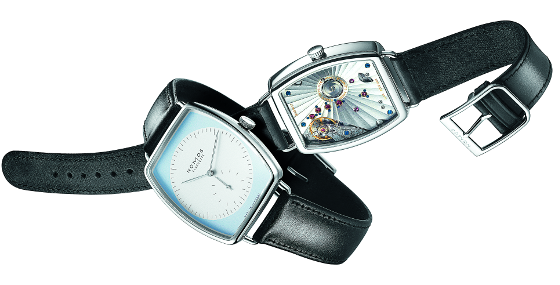
Both its case and its movement are tonneau shaped. The outer part of the dial frames the time display in robin’s egg blue. As Nomos points out in a press release, the styling of the dial, including its blue color, recalls a Bauhaus-inspired kitchen clock that Max Bill designed for Junghans in 1957. The blue is a good match for the watch as a whole. It also softens the otherwise severely geometric architecture of slim, straight hands and indexes. (There is also an all-white-dial version of the watch.) The Lux is instantly identifiable as a Nomos: its dial and hands call to mind the Orion, a round watch that is one of Nomos’s best-known models. The Lux case looks very compact, and the rounded corners and edges feel nice to the touch. The crystal has a slightly convex bulge. Slender stirrups anchor the strap, giving space between it and the case. They conceal sprung crosspieces that can be opened without tools by moving the little slides on the underside of the strap. The time is perfectly legible. The narrow hands contrast well enough with the dial, but their widths are nearly identical; and the hour indexes are only slightly longer than the minutes indexes. The watch is very comfortable: the strap feels soft and supple; the buckle isn’t unnecessarily bulky. The watch is pleasantly light in weight and no sharp edges can be seen or felt. But with its smooth back, this watch has a tendency to slide around on a narrow wrist.
Nomos offers only two options for the strap: black or dark brown horsehide. The Horween Tannery in Chicago supplies this long-wearing leather, tanned over the course of six months. Nomos also uses this so-called “shell cordovan” leather, taken from the horse’s hindquarters, for the straps on its other models, but the Lux strap is more thickly padded for a fuller look than the straps on the other watches. The white-gold buckle is new, too. When it’s closed, the rear crosspiece comes to rest atop the strap, where it doubles as a belt loop. This practical detail is a handsome visual echo of the slender strap lugs. Like the case, the clasp is meticulously polished, although scrutiny through a loupe discovered slight tool marks on the buckle’s underside. Careful examination of the case finds milled notches, which help a watchmaker lift off the snap-on back and bezel. The craftsmanship as a whole is quite good.
It’s particularly impressive on the movement. Caliber DUW 2002, made in house, conforms to the tenets of traditional Glashütte watchmaking: it has a three-quarter plate, screwed gold settings, a swan’s neck fine adjustment mechanism and a hand-engraved balance cock. The screw balance and decorations also show signs of excellent craftsmanship: the screws are blued, their heads are polished, and the edges of flat components are beveled and polished. The crown wheel, which is visible through the transparent caseback, boasts a Glashütte sunburst pattern and is positioned at the center of a sunray motif that radiates across the plate. This decoration looks very handsome, but through a loupe one can see vertical stripes left on the plate when the circular graining was milled. A hidden message in cursive writing comes to light when one examines the manual engraving on the balance cock. It reads, “Mit Liebe gefertigt in Glashütte” (“Made with love in Glashütte”). The two directions for fine adjustment – nach (loss) and vor (gain) – are also engraved by hand. The window occupies nearly the entire caseback, and through it one can read the gold-filled engravings that give the caliber number, jewel count, serial number and company name. The two barrels are positioned under the jewels, which lack settings. The barrels give the movement an ample 84-hour power reserve. Our tested watch proved its mettle and kept running for the promised 3½ days. The Lux has a stop-seconds function that enables the wearer to set the watch precisely to a time signal. Pulling out the crown stops the balance, and hence the seconds hand. The crown is well shaped, making winding and setting easy.

Caliber DUW 2002 is not new. (“DUW” stands for Deutsche Urhrenwerk, or “German watch movement.”) It has been available since 2006, and was first used in a watch marketed under the name of the German retailer Wempe. (The watch is still available, although Nomos no longer sells movements to Wempe.) Nomos finely adjusts the movement in six positions and according to chronometric specifications, although it is not officially certified. The Lux we tested passed the timing tolerances required for chronometer certification, but only barely: on our timing machine, the daily deviations in the various positions ranged between -1 and +5 seconds, so the greatest deviation among the several positions was 6 seconds. The average deviation was a pleasingly low +1.7 seconds, but the amplitude waned in the flat positions.

The price for the Lux, $20,500, approaches the prices that Patek Philippe and A. Lange & Söhne charge for three-handed dress watches. For that sum, you’ll get a fine timepiece, but you won’t get the impressive cost-benefit ratio of Nomos’s basic models like the Tangente. Image usually plays a big role in this upper price tier, and Nomos hasn’t yet earned a correspondingly refined image. Furthermore, the Wempe Chronometerwerke Glashütte, which has the same movement as the Lux, also in a gold case, costs 40 percent less than the Lux.
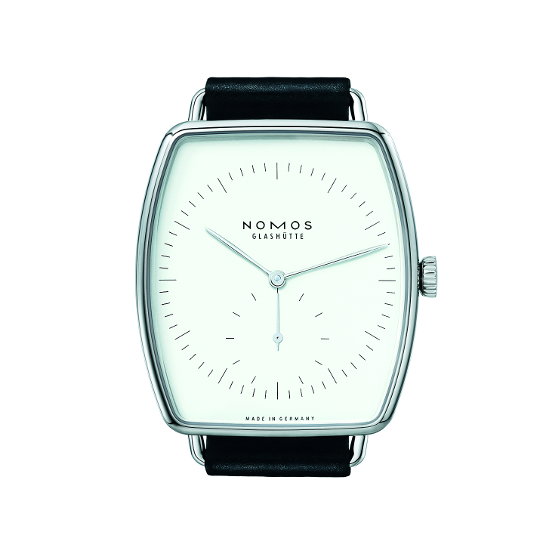
Nomos has remained loyal to its tradition. The Bauhaus-inspired styling of this brand’s other watches continues in the Lux, although its tonneau case and blue dial won’t appeal to everyone. We’re enthusiastic about the case, strap, buckle and the Glashütte-style manufacture movement, although scrutiny through a loupe disclosed a few slight traces of neglect. The cost-benefit ratio is not as impressive as in other Nomos models, but you still get a lot for the price. The bottom line: if you’re fond of this watch’s Bauhaus design and its pastel blue dial, your money will buy you a high-quality watch.
SPECS:
Manufacturer: Nomos Glashütte SA, Roland Schwertner KG, Ferdinand-Adolph-Lange-Platz 2, D-01768 Glashütte, Germany
Reference number: 920
Functions: Hours, minutes, small seconds
Movement: Hand-wound manufacture Caliber DUW 2002, 21,600 vph, 23 jewels, stop-seconds function, screw balance, swan’s neck fine-adjustment mechanism, power reserve = 84 hours, dimensions = 28.8 x 32.6 mm x 3.6 mm
Case: White-gold case, cambered sapphire crystal, snap-on back with sapphire window, water resistant to 30 m
Strap and clasp: Horsehide strap with white-gold pronged buckle
Rate results:
Deviations in seconds per 24 hours
Dial up +5
Dial down -1
Crown up +1
Crown down +3
Crown left +2
Crown right 0
Greatest deviation of rate 6
Average deviation +1.7
Average amplitude:
Flat positions 263°
Hanging positions 227°
Dimensions: 36 mm x 40.5 mm, height = 8.95 mm, weight = 77 g
Price: $20,500
SCORES:
Strap and clasp (max. 10 points): The robust strap and the attractively slim (but not perfectly polished) pronged buckle go well with this watch’s styling. 8
Operation (5): Thanks to the crown’s shape and the stop-seconds function, it is easy to wind the watch and set it with to-the-second accuracy. 5
Case (10): The well-crafted case is handsomely rounded and has a cambered sapphire crystal. 9
Design (15): This design doesn’t suit everyone’s style, but it’s inarguably harmonious and well balanced. 13
Legibility (5): The hour and minutes hands are too similar to each other and the hour indexes are too short. 3
Wearing comfort (10): A supple strap and low overall weight make it easy to forget that you’re wearing this watch, which has a pesky tendency to slide around on narrow wrists. 8
Movement (20): All the special features of Glashütte watchmaking, along with plenty of handcraftsmanship, are evident in this fine caliber. 16
Rate results (10): The movement performed with good individual rate results and low average deviation, but the amplitudes could have been higher. 7
Overall value (15): The high price gets you a high-quality wristwatch, but the resale value is speculative for a Nomos watch in this new, higher-priced category. 12
TOTAL: 81 POINTS
This article appeared in the June, 2014 issue of WatchTime Magazine.



